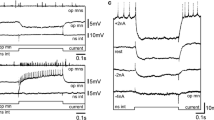Summary
A large descending interneuron in the crab (fibre 5) has three input channels which have been shown to be separate by selective inactivation. These are (1) statocyst input (2) leg joint input and (3) a non specific input. Excitatory statocyst input has been reported previously (Fraser and Sandeman, 1975; Fraser, 1975), and inhibitory statocyst input has been demonstrated by examining the combined effect of statocyst input and other inputs. Leg joint input occurs when the coxopodite of any leg is retracted at the thoracic-coxopodite (T-C) joint. The effect of this input is to increase the frequency and duration of fibre 5 firing to a displacement of the body of the crab relative to the legs (Fig. 2). Non specific input occurs most readily in a well rested animal which is inverted. A single touch anywhere on the crab elicits a sustained high frequency train of spikes which is correlated with cyclical leg movements (Fig. 1). Cutting the optic tracts abolishes this pathway.
Fibre 5 inScylla has an overt behavioural correlate in the stereotyped pattern of leg movements associated with the non specific input. This same behavioural sequence can be evoked during rotation of the crab and on low current electrical stimulation of fibre 5. Fibre 5 can thus be regarded as a command fibre for this reflex.
Similar content being viewed by others
References
Bethe, A.: Das Nervensystem vonCarcinus maenas. Arch. mikr. Anat.50, 460–546 (1897)
Burrows, M., Rowell, C. H. F.: Connections between descending visual interneurons and metathoracic motoneurons in the locust. J. comp. Physiol.85, 221–234 (1973)
Bush, B. M. H., Godden, D. H.: Tension changes underlying receptor potentials in non-impulsive crab muscle receptors. J. Physiol. (Lond.)242, 80P-82P (1974)
Bush, B. M. H., Wiersma, C. A. G., Waterman, T. H.: Efferent mechanoreceptive responses in the optic nerve of the crabPodophthalmus. J. cell. comp. Physiol.64, 327–346 (1964)
Clarac, F., Dando, M. R.: Tension receptor reflexes in the walking legs of the crabCancer pagurus. Nature (Lond.)243, 94–95 (1973)
Cochran, D. M.: The skeletal musculature of the blue crabCallinectes sapidus Rathbun. Smithsonian misc. Coll.92, 1–76 (1935)
Davis, W. J.: Lobster righting responses and their neural control. Proc. roy. Soc. B70, 435–456 (1968)
Fraser, P. J.: Interneurones in crab connectives [Carcinus maenas (L.)]: Directional statocyst fibres. J. exp. Biol.61, 615–628 (1974)
Fraser, P. J.: Free hook hair and thread hair input to fibre 5 in the mud crab,Scylla serrata, during antennule rotation. J. comp. Physiol.103, 291–313 (1975)
Fraser, P. J., Sandeman, D. C.: Effects of angular and linear accelerations on semicircular canal interneurons of the crabScylla serrata. J. comp. Physiol.96, 205–221 (1975)
Hazlett, B. A.: Non visual functions of crustacean eyestalk ganglia. Z. vergl. Physiol.71, 1–13 (1971)
Kennedy, D.: Crayfish interneurons. Physiologist14, 5–30 (1971)
Mendelson, M.: Oscillator neurons in crustacean ganglia. Science171, 1170–1173 (1971)
Pearson, K. G., Fourtner, C. R., Wong, R. K.: Nervous control of walking in the cockroach. In: Nervous control of posture and locomotion (Stein, R. B.,etal., eds.). Advances in Behavioural Biology, vol. 7 (1974)
Taylor, R. C.: Environmental factors which control the sensitivity of a single crayfish interneuron. Comp. Biochem. Physiol.33, 911–921 (1970)
Wiersma, C. A. G., Fiore, L.: Factors regulating the discharge frequency in optomotor fibres ofCarcinus maenas. J. exp. Biol.54, 497–505 (1971)
Wiersma, C. A. G., Oberjat, T.: The selective responsiveness of various crayfish oculomotor fibres to sensory stimuli. Comp. Biochem. Physiol.26, 1–16 (1968)
Author information
Authors and Affiliations
Rights and permissions
About this article
Cite this article
Fraser, P.J. Three classes of input to a semicircular canal interneuron in the crab,Scylla serrata, and a possible output. J. Comp. Physiol. 104, 261–271 (1975). https://doi.org/10.1007/BF01379052
Received:
Issue Date:
DOI: https://doi.org/10.1007/BF01379052




